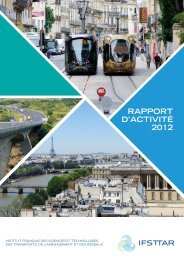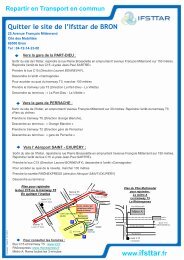french institute of science and technology for transport ... - Ifsttar
french institute of science and technology for transport ... - Ifsttar
french institute of science and technology for transport ... - Ifsttar
Create successful ePaper yourself
Turn your PDF publications into a flip-book with our unique Google optimized e-Paper software.
2_SCIENTIFIC AND TECHNICAL ACTIVITIES<br />
Accident rates among<br />
powered two-wheelers<br />
PTWs really deserve a research programme<br />
For nearly two years, researchers from a variety <strong>of</strong><br />
disciplines (cognitive psychology, social psychology,<br />
vehicle <strong>and</strong> infrastructure engineering, biomechanics)<br />
have been investigating the thorny problem <strong>of</strong> powered<br />
two-wheelers (PTWs). In addition to analyzing accident<br />
processes <strong>and</strong> contributory factors, the COMPAR<br />
project is attempting to identify the psychosocial determinants<br />
<strong>of</strong> PTW user behaviours. The study has<br />
thus employed two complementary methodological<br />
approaches. Two IFSTTAR units, MA <strong>and</strong> LBA, are<br />
involved in COMPAR.<br />
Scenario 1: a third party<br />
vehicle drives onto a main<br />
road without having priority<br />
in spite <strong>of</strong> the arrival <strong>of</strong> a<br />
PTW, which collides with it.<br />
Scenario 2: a third party<br />
vehicle makes a left turn<br />
manoeuvre in spite <strong>of</strong> the<br />
arrival <strong>of</strong> a PTW travelling<br />
in the opposite direction.<br />
66<br />
This research involves three approaches. The first<br />
attempts to identify the principal accident configurations <strong>for</strong><br />
PTWs based on a detailed analysis <strong>of</strong> 1,000 accident reports.<br />
The purpose <strong>of</strong> this work is to identify the main factors <strong>and</strong><br />
the principal ways they combine to determine the nature <strong>of</strong><br />
accidents.<br />
The second approach is a psychosocial analysis based on<br />
survey data. The aim is to define <strong>and</strong> describe the pr<strong>of</strong>iles <strong>of</strong><br />
PTW users <strong>and</strong> identify the psychosocial determinants <strong>of</strong> their<br />
adoption <strong>of</strong> “risky” driving styles.<br />
The third approach used Detailed Accident Studies to investigate<br />
PTW speeds in relation to the difficulties other road users<br />
experience in detecting them.<br />
Last, a complementary study more concerned with “secondary<br />
safety” relates to the protective efficacy <strong>of</strong> so-called “light” PTW<br />
safety equipment (summer jackets).<br />
@ CONTACTS<br />
catherine.masson@ifsttar.fr, isabelle.ragot-court@ifsttar.fr<br />
& pierre.van-elsl<strong>and</strong>e@ifsttar.fr<br />
Monitoring the ESPARR cohort<br />
Exceptional data<br />
Its unique nature means the ESPARR (1) cohort <strong>and</strong> the<br />
research based on it provide a fundamental scientific<br />
apparatus <strong>for</strong> deciding on appropriate concrete measures<br />
to reduce accidents <strong>and</strong> <strong>for</strong> monitoring casualties.<br />
Although fatality figures are <strong>of</strong>ten quoted, less attention<br />
is given to the large number <strong>of</strong> casualties who survive,<br />
sometimes with disabilities that are not visible.<br />
In 2011, monitoring ended <strong>of</strong> the 1,372 road accident<br />
casualties who had agreed in 2004 <strong>and</strong> 2005 to join the<br />
ESPARR cohort <strong>and</strong> be monitored <strong>for</strong> five years. One <strong>of</strong> the<br />
qualities <strong>of</strong> the cohort is that it is a representative subsample <strong>of</strong><br />
the Rhône Département Road Traffic Casualty Register which<br />
means the findings can be extrapolated to this population.<br />
While receiving treatment in the hospitals in the Rhône Département,<br />
the subjects were asked to provide regular accounts <strong>of</strong><br />
the way the accident had affected their lives from the physical,<br />
psychological, family, social, occupation <strong>and</strong> financial points <strong>of</strong><br />
view. The subjects with the most severe injuries were <strong>of</strong>fered a<br />
medical appointment in their home one, three <strong>and</strong> five years after<br />
the accident with a clinical <strong>and</strong> neurocognitive assessment.<br />
(1) Study to Monitor a Population <strong>of</strong> Road Traffic<br />
Accident Casualties in the Rhône Département.<br />
ifsttar French Institute <strong>of</strong> Science <strong>and</strong> Technology <strong>for</strong> Transport, Development <strong>and</strong> Networks






![Trajectoire le magazine n°3 - Juillet 2012 [.pdf] - Ifsttar](https://img.yumpu.com/30038493/1/190x253/trajectoire-le-magazine-na3-juillet-2012-pdf-ifsttar.jpg?quality=85)

